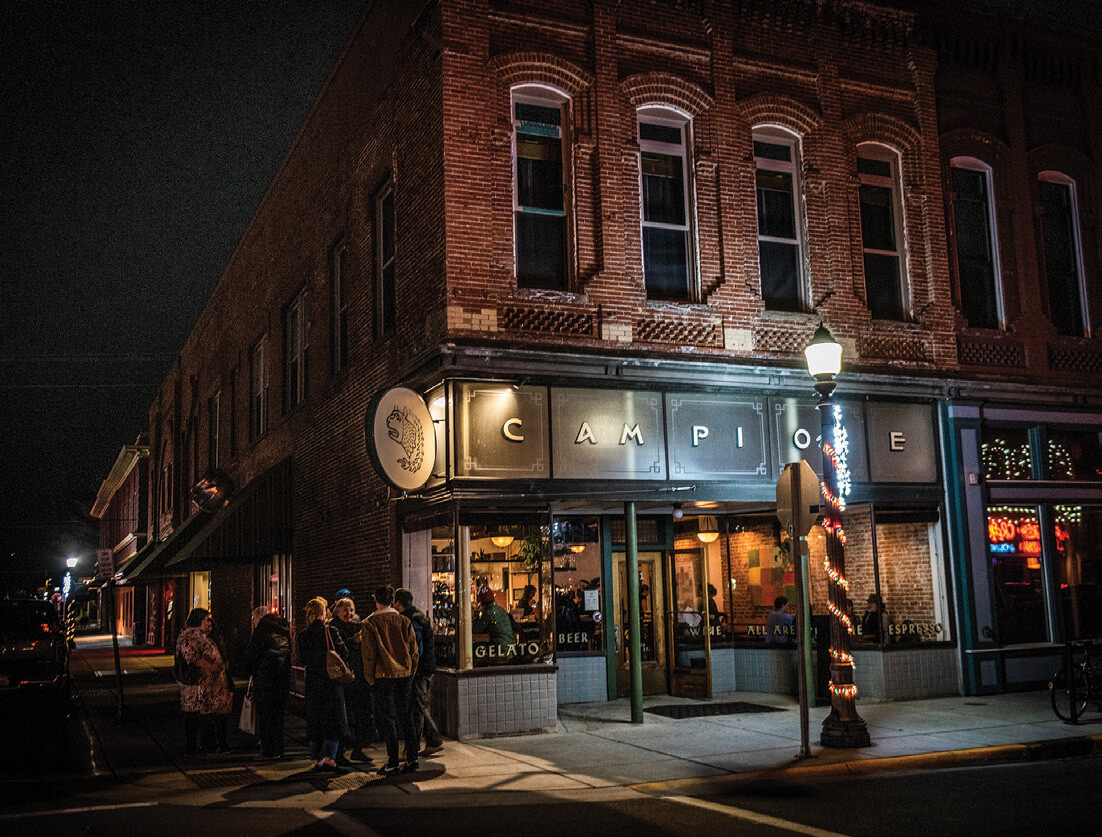
01 Feb Dining Out: Campione Roman Kitchen
From any angle where Main Street meets Callender, the corner restaurant looks unassuming enough. Warm yellow light emanates from within as dusk falls. A handful of people in ski coats and Carhartts gather outside, waiting for the door to open at 5 o’clock. On the windows, in cream-colored Roman lettering, is written “meatballs” next to “espresso” and “gelato.” It’s a familiar place, this red brick building set in the heart of downtown Livingston, Montana, a natural place for an eatery. And there have been plenty here: pizza joints, bakeries, even a bodega that sold everything from batteries to macaroons. On another window, behind the growing crowd of people, are the words “All Are Welcome.”
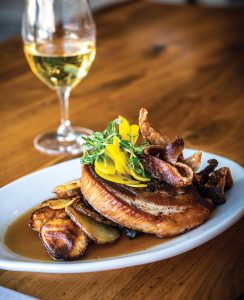
The porchetta special is slow-roasted pork belly stuffed with Montana black chickpeas, mushrooms, apple, and fresh herbs — served over duck fat-roasted potatoes and braised greens — with pork jus and crispy pork skins.
Inside, the first thing you see — after you smell baked bread and garlic sizzling in olive oil — is a black-and-white mosaic in the honeycomb tile floor reading “In the Service of Others. Est. 2020.” It calls to mind the words inscribed on the Roosevelt Arch at Yellowstone’s north entrance: “For the Benefit and Enjoyment of the People.”
Before a minute passes, you are shown to a thick walnut table with a carved iron base and wooden bistro chair that looks like it belonged in an ice cream parlor back when Livingston was more trains than trout. There’s music in the background, an old record player and a thick stack of albums in the corner. It’s familiar, this song, but you don’t know the words. The people at the next table are already clinking their glasses and laughing. They wish a happy anniversary to the couple two tables over. It feels more like a dinner party than a restaurant here. It’s so informal that even if you’ve read the news, it’s easy to forget that this place, Campione Roman Kitchen — opened by three friends at the height of the pandemic — was recently named by The New York Times as one of the best 50 restaurants in the United States.
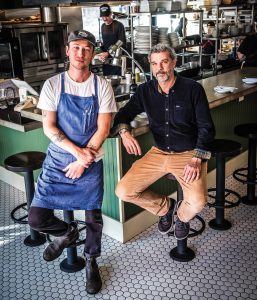
Two of the three partners — Anthony Sferra and Jeff Galli (from left) — take a moment before the restaurant opens for dinner. Their third partner, Josh Adams, is not shown.
Co-owner Jeff Galli isn’t that interested in talking about the recent accolades. He’d rather talk about the history museum in the old schoolhouse where the three partners found some of the photographs that hang on the restaurant’s walls, or about Campione’s location on this corner — “a crossroads,” he calls it. He’d rather talk about Livingston and how much he loves it here.
“There deserves to be a gathering place for our community,” he says. And when he, Josh Adams, and Anthony Sferra dreamed this place up, bought the old Farmgirl Pizza in November 2019, and set about remodeling the space on day one, there was almost no discussion, “no hemming and hawing,” Galli says. “It was a shared vision about being a benefit to the community first, about doing good things for the people who are here,” he explains. And then about making some magic.

The three partners, all with abundant experience in the restaurant world, opened Campione in the thick of the pandemic, after nine months of renovating the space themselves, which included adding their motto to the tiled floor.
The one-page paper menu you’re offered hints at magic, with ingredients like cashew cream, shredded oxtail, shallot agrodolce, and tarragon salsa. You haven’t learned yet that the specials today include slow-roasted pork belly stuffed with Montana black chickpeas, mushrooms, apples, and herbs, served over duck fat-roasted potatoes; and scallop tartare in a fennel basil emulsion with preserved duck yolk blanketing the cake-shaped delicacy in gold. A couple of days ago, you could have tried the charred bison heart with an espresso chile rub. Until your first plate arrives, you may not know that everything here is made simply, from the best local and seasonal ingredients. Galli notes that the chefs have no fear of big flavors. “If you’re gonna eat, you should eat,” he says.
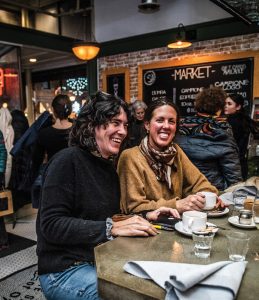
Diners enjoy an after-dinner espresso in Campione’s festive environment.
Here’s my advice: Start with an appetizer. Share the meatballs or the fritto misto. Order at least one salad: the panzanella or the arugula. Consider every special very carefully, as if this is the best meal you will have for a while. Because it is. Ask Galli for a wine recommendation and trust entirely that the night’s house selection of both red and white will be sensational. (Write them down or take a picture so you can try to find them in the store and remember this night.) Though the menu suggests pasta and main courses are separate, don’t be afraid to form a team with your dinner mate to mix and match. You could get the Pasta dei Campioni — what Galli describes as their own take on the classic Roman cacio e pepe — with fresh pappardelle, roasted mushrooms, mustard greens, Pecorino Romano, and cracked pepper. And your companion might try the braised beef short ribs with herbed polenta cake, natural pan sauce, arugula, Pecorino, and parsnip chips. Or there’s the Flathead Lake trout, which is prepared with rich, earthy ingredients during the winter and crisp, fresh flavors come spring. The lamb ragu is another favorite, as is the linguini with meatballs.
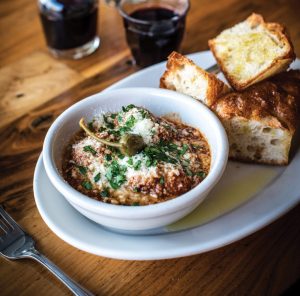
Among the hot starters is this meatball dish of Montana pork and beef with red sauce and Pecorino, served with Campione’s own focaccia.
“It’s recognizable as Italian,” Galli says of everything on the menu, “but very much Montanan.” What you won’t find on the menu, he says, are the ubiquitous Montana-menu staples like hamburgers, steak, Caesar salad, and ranch dressing. But believe me: You won’t miss them. And whatever you do — even if you don’t leave room, even if you think you can’t — order dessert anyway. Maybe the Torta all’Arancia or the Broken Cheesecake.
If you can pull your eyes from the sculptural creations on your plate long enough to watch the flow of diners, you’ll notice the bar seats are always full, and the tables are too. People linger outside under the streetlight, waiting for the seven bar seats reserved for walk-in diners. They don’t seem to mind the cold. When they come in, Galli greets them as old friends because likely, they are. People don’t dine at Campione just once. It’s part of the magic. You get this by now.
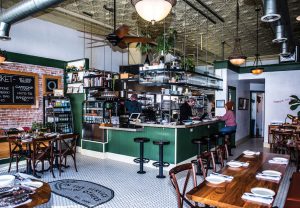
The design elements of the restaurant — exposed brick, tile floor, tin ceilings, and antique tables and chairs — belong to another era and lend a warmth and coziness to the space. There is nothing stuffy or pretentious within these four walls.
There are only 37 seats in the restaurant, and the line outside often starts forming before Campione opens. “We fight hard to make sure that people who want to be here get to be here,” says Galli. For him, that means daily hours spent answering the phone to assist people with dinner reservations. He has a color-coded calendar so that he can find a table for you, if not on the exact day and time you wanted, then something close. “I don’t like saying, ‘no,’” he says. “And we don’t want people to have to think a month ahead to get in.” Making Campione accessible also means keeping a close watch on food, labor, and energy costs so that the most expensive entrée on the menu doesn’t go higher than $32. “You shouldn’t have to think twice about coming out on a Thursday,” he says.
But, that magic? The magic is real. It is in the flavors and beauty of the food, the sincere warmth with which you are welcomed in, the classic elegance of green glass bottles on thick wooden tables beneath a tin ceiling. And it’s the energy in this softly lit room. “You can’t really explain it, but you want to be here,” Galli says.
Indeed.
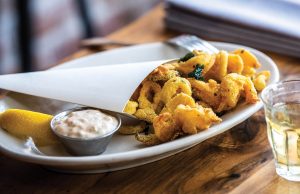
The fritto misto starter, served with preserved lemon aioli, is among the house favorites.
At the end of the meal, when you go to look at the 1909 panoramic photo of the very corner where you are having dinner, you see a staircase leading down to the storage room. On the wall, framed, but hung a little cock-eyed and trimmed unevenly, as if with a child’s scissors, is a 2023 newspaper clipping from The New York Times: “The Restaurant List: The 50 places in the United States that we’re most excited about now,” the headline reads. And there it is: Campione. Livingston, Montana.
Now you know the headline is true. But even better, after this meal, after this night, you believe.
Campione Roman Kitchen is open for dinner Wednesday through Sunday, 5 to 9 p.m., and for a first-come-first-served brunch on Saturday and Sunday, from 10 a.m. to 1:45 p.m. Dinner reservations can be made by calling (406) 333-2427 or emailing events@eatcampione.com. Bar seats are open for walk-ins throughout the evening. Lines often form 10 to 15 minutes before opening in winter, and earlier in summer.
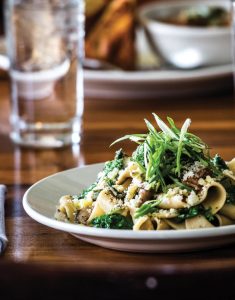
The Pasta dei Campioni features handmade pappardelle with roasted mushrooms, mustard greens, Pecorino Romano, and cracked pepper. It’s the restaurant’s own delicious take on the Roman staple cacio e pepe.
Carter Walker is the author of several guidebooks, including Moon Montana & Wyoming (November 2022), Moon Montana (January 2023), Moon Wyoming (January 2023), and Moon Yellowstone to Glacier National Park Road Trip (May 2023). She lives in the Horseshoe Hills of Montana with her two daughters and a motley collection of well-traveled animals.
Photographer Lynn Donaldson shoots regularly for National Geographic, National Geographic Traveler, Travel & Leisure, Sunset, and The New York Times. The founder and editor of the Montana food and travel blog The Last Best Plates, Donaldson lives outside of Livingston, Montana with her husband and three children.




No Comments